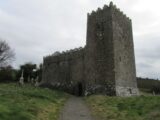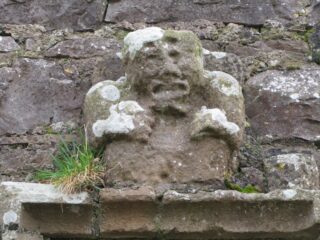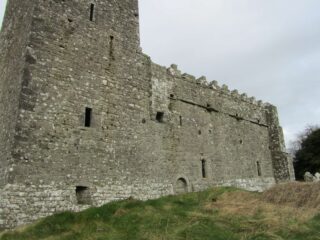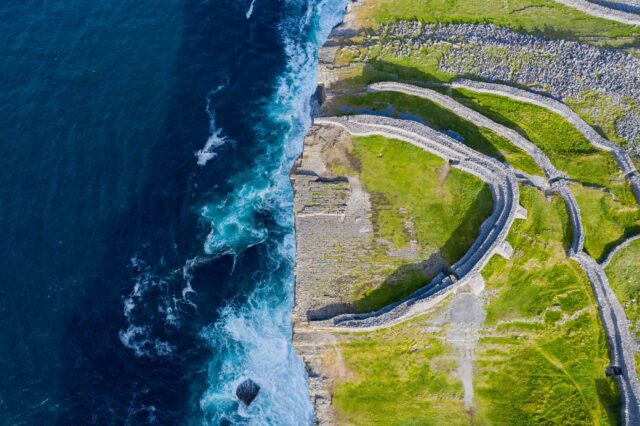Fógra
WARNING: It should be noted that these sites are unguided and a level of care and caution should be maintained during all stages of your visit. The Office Of Public Works (OPW) will not be held responsible for any damages, injuries, or losses that occur
Taghmon – St. Munna’s Church
To the east of the village Crookedwood, on the L1618, lies the townland of Taghmon and in it, at a distance of 1.8km (1.12 miles) from Crookedwood, on the south side of the road, is the little gem of a fortified ecclesiastical building known as St. Munna’s Church, or Taghmon.
St. Munna, otherwise known as St. Fintan Munnu, whose feast day is the 21st October and who died in 634AD, established a monastery in Wexford, which was named, in Irish, Teach Munna, after him. The parish of Taghmon in Westmeath also derives its name from him. The saint is recorded as having founded a monastery on the site of the present church, but nothing obvious remains of that early establishment other than the shape of the boundary wall of the adjoining churchyard, which is thought to delineate its early enclosure.
The site sits in a hollow at the foot of a small, but steep hill on the north side of the road from which stands the last remnants of Taghmon Castle, which was owned by the Nugent family. In 1452, the castle and church were plundered and burned by Feargal MacGeoghegan, which reasonably explains why the earliest identifiable elements of the present church date from no earlier than the 15th century.
Harold G. Leaske, in his extensive and authoritative analysis of this site for the Journal of the Royal Society of Antiquaries of Ireland (1928), describes the location of the church in picturesque language. "The contrast of the physical features of this region with the wide plains of Westmeath and the fine views of them and of Lough Derravarragh to be had from the slopes perhaps justify, if altitude does not, the name of 'mountain parish’ by which it is known."
The list of the church’s incumbents was recorded in the Reverend John Healy’s 'History of the Diocese of Meath' (1908) and spanned over 400 years between 1434 and 1845.
During the 16th century, St Munna’s came into the possession of the Nugent family but fell into complete disrepair within 100 years. In 1619, Sir Christopher Nugent, of Moyrath in Meath and Farrow in Westmeath, died and was buried at Taghmon. By 1622 the church was described by Bishop Ussher as being in a ruinous state. Tradition also holds that during a siege of the nearby castle by Oliver Cromwell and his soldiers in 1649, the Parliamentarian Lieutenant-General slept the night at Taghmon church.
Following over a century of neglect, in 1755 Taghmon was once again being used by the Church of Ireland for services. After a visitation by Bishop Ellis he wrote that "There is a church in repair with a steeple in this parish. It has a stone roof, which is cracked from end to end and lets in the rain, the inside is in a very sorry order and everything also wanting……..It is a very obscure place and there is a very small congregation." .
In 1843 extensive restoration work to the church was carried out under the supervision of Joseph Welland, head architect for the Board of Ecclesiastical Commissioners, all of which was completed by 1847. A small portfolio of drawings for these changes is held at the library of the Representative Church Body in Dublin.
As for the restored building itself, it consists of a single barrel-vaulted apartment of nave and chancel, with a four-storey western tower that is vaulted on the first and third storeys. Slates cover the church’s concrete roof and the parapets are crenelated, as are those of the oblong tower, giving the overall impression of a well-fortified building.
The interior of the church is practically devoid of decoration, though there are three aumbries, or small cupboards for religious vessels, under the north, south and east windows. The main entrance door is located in the north wall, over the exterior pointed arch of which there is the weathered carving of a face. Another such weathered face is placed one-third of the way up on the north-west angle of the tower. More impressively, and mysteriously, above the window to the left of the main door, outside, is the most fantastical grotesque figure known as a sheela-na-gig.
A much smaller door, now blocked in, sits in the south wall. In each of these same north and south walls are two very narrow inwardly-splayed single light windows, each with well-wrought, though now somewhat distressed, sandstone ogee-cusped heads, under square label mouldings, that are highly characteristic of the 15th century. These are most likely to have been recycled elements salvaged from an older church on this or some other site. The interior of the south wall also has a finely-carved piscina and double aumbry. A modern pointed 19th century window in the east wall is seen to be in good condition in a 1928 photograph.
As for the tower, all of the rooms in this end of the building strongly indicate that it was used as a residence. Above the ground-floor store, the first-floor chamber is vaulted and is lit by two small inwardly and outwardly splayed rectangular windows, with seats in the wide recesses, as well as a wide fireplace and a sink or slop stone. On the second floor there is a bedroom with no fireplace but it does contain a small garderobe or toilet. Up on the third floor is another living room, again with no fireplace, off of which is a small chamber just big enough for a bed. In the north-east corner of the tower a circular staircase leads to each floor and up on to the roof.
In 1926 the Representative Church Body vested the building in the Commissioners of Public Works for preservation as a national monument.
Visit Historic Environment Viewer for more information on Taghmon Church
Protect our Past - Click here to read about the importance of protecting our country’s unique heritage sites
This national monument is protected in accordance with the National Monuments Acts 1930 to 2014




